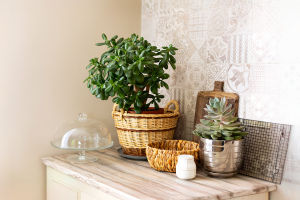When we hear the word “shy,” our minds often picture a young girl blushing after a sweet moment or teasing smile. But have you ever imagined a plant being shy? Sounds strange, right? In nature, there’s actually a plant that truly earns its shy reputation—Mimosa pudica, commonly called the “sensitive plant” or “shy plant.”
Its leaves fold inward and droop at even the slightest touch, making it one of the most fascinating and playful plants we can grow at home. Let’s explore this magical green friend and learn how it captivates us with its unique behavior.
Getting to Know Mimosa Pudica
Originating in the Americas, Mimosa pudica is a low, spreading herb or semi-shrub that belongs to the legume family. Its stems are upright or slightly climbing, often covered with fine hairs and small prickles. Its leaves are pinnately arranged with numerous small, oval leaflets, typical of legume plants. While many of the plants we see are small, it can actually reach up to one meter in height. Known also as the sensitive plant, shy plant, or bashful plant, it earned its name because its leaves fold together and droop when touched, giving it a whimsical charm.
Where We Can Spot It?
Though unusual, the shy plant grows in tropical and subtropical regions and can occasionally be found along roadsides, in open meadows, or urban green spaces. Its delicate, pink or light-red flowers bloom at the end of summer, forming dense, head-shaped clusters that look stunning up close. By autumn, it produces legume-like pods containing seeds. Its interactive nature and attractive flowers make it a favorite for indoor planting and gardening enthusiasts.
The Science Behind Its “Shyness”
We’re often curious about why this plant reacts so dramatically to touch. Modern science has explained it clearly: the movement is caused by changes in water pressure inside the plant’s cells. When we touch the leaves, the cells at the base of the leaflets quickly lose water, lowering internal pressure and causing the leaves to fold and droop. It’s a remarkable example of how plants respond to their environment—and it certainly adds a playful element for anyone growing it at home.
Floral Symbolism
The shy plant’s “bashful” behavior has inspired symbolic meanings too. In floral language, it represents shyness, sensitivity, and politeness. Its delicate movements make it a wonderful gift or desk companion, reminding us to slow down and observe life’s little wonders. Its whimsical personality adds charm to any space and encourages us to notice the small interactions in nature.
Why We Should Value It?
Beyond its playful movements, Mimosa pudica has a long history of medicinal use. Traditional herbal medicine considers the plant bitter, slightly cold, and helpful for clearing heat, relieving dampness, calming the mind, and detoxifying the blood. Some references note its ability to reduce swelling and relieve minor pain. So while it may shy away from touch, it quietly offers a host of benefits to those who cultivate it.
Bringing It Into Our Lives
Lykkers, growing Mimosa pudica can be a delightful experience. With a little attention to sunlight and water, we can enjoy its whimsical movements every day. It’s not just a plant—it’s an interactive green companion that sparks curiosity, teaches us patience, and adds charm to our indoor spaces. Next time we see one at a nursery or in the wild, let’s give it a place in our homes. Touch its leaves, watch them fold, and smile at this tiny, shy miracle of nature.
Enjoy the Shy Magic!
The shy plant shows us that even the smallest living things can bring big surprises. From its playful leaf movements to its gentle medicinal qualities, Mimosa pudica is a delightful companion. By observing its behavior and appreciating its subtle beauty, we can add tiny moments of joy and wonder to our daily life. Let’s welcome this charming plant into our homes, have fun watching its shy reactions, and treasure the magical little moments it shares with us.


